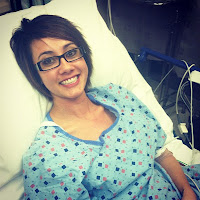I've been a cardiac nurse for two years, worked on a cardiac floor for four years, and am specializing in cardiology for graduate school. I absolutely loooove the human heart - I think it's fascinating!
March 3rd ~ woke up from nap with all sorts of symptoms... tachycardia, chest pain, shortness of breath with activity, anxiety, and fatigue. And that's when the whirlwind started. I got to wear a 30 day holter monitor, save my urine in the fridge for 24 hours, and have some other delightful tests.
Initially, everything was attributed to postural orthostatic tachycardia syndrome or POTS. I started drinking lots of fluids, increasing my salt intake, exercising, and taking Metoprolol. Easy peasy. I even started feeling better minus the chest pain.
April 11th ~ CT coronary angiogram. My cardiologist ordered this test on a whim since I was still having chest pain... she figured since I was already having a CT of my chest I might as well [after I had the angiogram I got a letter from my insurance saying they weren't going to pay for it cause it wasn't "necessary" oh please].
CT coronary angiogram = an imaging test to look at the arteries that supply your heart muscle with blood
by the way contrast dye sucks! One of the side effects is that you feel like you peed yourself and even knowing that in advance [I warn my patients about this] oh my goodness I thought for sure I had ACTUALLY peed myself :)
April 12th ~ Surprise!!! you have a congenital coronary artery anomaly and need open heart surgery at the Mayo Clinic. WHAT?!
Source | Family Practice Notebook
So my right coronary artery or RCA comes off the left side [just had to be difficult]. The problem isn't necessarily that it's on the wrong side but rather that it originates between the aorta and pulmonary artery causing 25-50% compression of the artery. This defect is pretty rare only approximately 1/100-120 babies are born with it.
The risk of sudden cardiac death for right sided coronary anomalies is undocumented in research or unknown. There are three reasons that would indicated the need for surgery... I had two.
- failing a stress test which would indicate ischemia or damage to the heart
- symptoms [check]
- having a cardiologist place restrictions on your activity [check]
May 13th ~ unroofing procedure at St. Mary's Hospital Campus, Mayo Medical Center
After the initial shock of finding out I needed open heart surgery I was kind of excited. The cardiac nurse was becoming the cardiac patient. I've always been on the nurse side of cardiac surgery and now I got a pretty unique look at the patient side. I am so thankful for this crazy/fun experience - I learned so much and now I know what patients go through! Watch out future patients this lady knows all the tricks... yes you do need to get out of bed and walk! :) :) :)
More thoughts on this cardiac surgery adventure to come...
* * * * *
Update: My health adventure has continued since having open heart surgery in the Summer of 2013. Since then we (the doctors and myself) have found that many of the symptoms that lead to finding the congenital coronary artery anomaly were actually caused by neurocardiogenic syncope, a type of dysautonomia or dysfunction of the autonomic nervous system. This autonomic disorder was diagnosed several months after surgery when my symptoms returned. Without those symptoms, the heart defect would probably have remained undetected. Since there's was a high risk of sudden cardiac death associated with my particular heart defect I have to say I'm thankful for the autonomic dysfunction... just have to keep reminding myself of that when I'm having these crazy symptoms!







0 comments:
Post a Comment